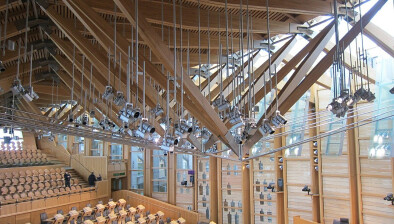Call for views launched on updated energy efficiency standards for social housing

Zero carbon buildings minister Patrick Harvie
Social landlords will have a “critical” role in driving demand for heat networks and can provide a “leading voice” in how we transform communities, Patrick Harvie has told Scottish Housing News after the zero carbon buildings minister published a consultation on updated energy efficiency standards for social housing.
Under proposals for a new Social Housing Net Zero Standard (SHNZS), social landlords would be required to meet an energy efficiency standard between 2033 and 2040 and install clean heating across their stock by 2045 where it is technically feasible and cost-effective to do so.
The consultation document sets out proposals for a new fabric rating to be introduced, which social housing will need to meet by 2033, and for the replacement of fossil fuel gas and electric heating systems with clean heat alternatives by 2045, such as heat pumps or solar thermal heating.
A consultation on Heat in Buildings for the wider housing sector has also been launched at the same time, which will introduce the same backstop of 2045 for the transition to clean heat.
Speaking to Scottish Housing News this morning, Mr Harvie said the proposals deliver the certainty and long-term planning that social landlords, developers and other impacted parties have long called for.
“We know where we need to get to by 2045,” he said. “Not just high performance in terms of energy standards and energy efficiency, but shifting away from fossil fuel for the way we heat our buildings. But we can’t wait until 2044 to see an impossible bottleneck, we need to give a clear sense of the direction of travel and confidence that this will continue to accelerate.”
“It has been accelerating, but we need to continue that trend progressively and we need businesses that housing developers work with, whether they are housebuilders themselves or other contractors, to have the confidence to invest in the skills and the capacity. We need to make it very clear to anyone who is looking at investing in the green transition that Scotland’s a great place to put your money and to build a business, whether innovating new products onto the market that will achieve the heat transition more affordably or just scaling up.
“In the construction sector, we’re already seeing changes of attitude and a lot less resistance to ambitious change than might have been the case 10 or 20 years ago. I think the construction sector knows that change is coming so we are working with the grain of that.”
Heat in Buildings Bill
As part of the Heat in Buildings Bill, Mr Harvie admitted that an initial target for one million homes to have low or zero-emission heating by 2030 is “unachievable” and will not be met until later in the decade.
And while most of the timescales set out in his initial strategy in 2021 remain intact, the phasing out of fossil fuel heating systems for off-gas homes, which were initially set to make changes from 2025, will now align with the majority of properties that are on gas mains supply. Under the plans, all homes will need to end their use of fossil fuel emission heating systems by 2045, when Scotland is due to become net zero in law.
Proposals in the Heating and Buildings Bill include:
- That private rented homes will be required to meet a minimum energy efficiency standard no later than 2028;
- That owner-occupied homes will be required to meet the same minimum energy efficiency standard by the end of 2033;
- That all homes and non-domestic buildings will be required to end their use of polluting heating by the end of 2045; and
- In order to create a smooth trajectory towards 2045, that those purchasing a home or non-domestic property before 2045 would be required to end their use of polluting heating systems within a specific period following that purchase.
Mr Harvie said the changes have made the proposals “fairer and clearer”.
“All the key dates that we set out in the 2021 strategy are still in place, what we have had to do is refine the expectation about how much of that heat transition we can achieve by 2030,” he told SHN. “And we recognise that more of that will happen in the early 2030s than by 2030.”
He added: “That is to take account of several things. Partly it’s the cost of living crisis, which is also the cost of doing business crisis. We know that construction is a sector where inflation has hit particularly hard, as well as the challenges in terms of labour supply post-Brexit, but we’ve also had to take into account the way that Westminster announcements have undermined investment throughout the UK.
“So we recognise that that goal of a million by 2030 is not the realistic path anymore and that we’re likely to see those kind of numbers enter the early 2030s instead of by 2030. But it doesn’t fundamentally change the trajectory that we’re on or indeed the actions that we need to take to support everyone whether its large-scale social landlords, community organisations, the construction industry itself, or indeed householders, and landlords.”
The announcement of a proposed Social Housing Net Zero Standard, and its focus on a fabric efficiency rating, comes in response to a report by the Zero Emissions Social Housing Taskforce (ZEST) which called for an accelerated review of the Energy Efficiency Standard for Social Housing (EESSH2), and alignment with Heat in Buildings to provide clarity for social landlords to guide retrofit and investment planning.
By setting out two options for the fabric efficiency rating in the consultation, Mr Harvie was asked whether the proposals will provide adequate incentive for landlords to carry out the most expensive upgrades.
“Well, very clearly there’s been a great deal asked of the social housing sector in particular,” he answered. “They’ve already led the way in energy efficiency but a whole host of other quality standards have improved and need to continue to improve and we’re looking to make sure that we offer a coherent package of what’s being asked rather than asking the impossible.
“We want to make sure that this is an achievable deliverable change, and that it can be done in the way that best suits the investment plans that each landlord will have. They will know their housing stock, they will know what their priorities are both in terms of retrofit and new supply and we know that we’ll need to make sure that the way that we support investment through the specific Social Housing Net Zero Fund, and the way that we support housing providers to do new supply - they need to fit together as well.
“I think offering some flexibility is the most effective way of getting results for people who are going to be living in those homes and paying their energy bills. But it’s also really consistent, I think, with the long-term direction of travel. We need to see fabric improvements, we also need to see by 2045, the end of fossil fuel heating systems and I think the package that we put out yesterday is a bold package, and one that can be a template for the rest of the UK.”
Financial support
On how to finance the transition, Mr Harvie said it was unrealistic not to proceed with the consultation until a clearer picture of all potential funding streams were in place.
“I think it’s inevitable that all of this will continue to develop over time,” he added. “We’re talking about more than 20 years’ worth of work and just as I think it would be unreasonable for me to say that the package of individual householders support that we have, generous though it is at the moment, that it’s never going to change, of course it’s going to have to change and refine over time to meet the changing circumstances. So the way that we support the social housing sector is also going to have to change over time.
“I don’t think it would be right to say that we’re not going to proceed with the consultation until we have every answer to every detail, because we’ll never be in that position. These aspects about how we’re going to fund the work that’s going to happen are going to continue to change over time. Take something like heat networks, for example, social landlords could be really pivotal organisations in providing demand assurance for heat networks, so that the investors know that there are the buildings, the homes and the customers to connect to those networks. That, criticality, is going to make those networks viable.
“Over time we’re going to be seeing continued innovation in how we bring together a range of different sources of investment from the social landlords investment programme, through individual building owners, through energy companies, financial products like green mortgages, and institutional investors that are interested in things like heat networks.”
Sector response
Sally Thomas, the Scottish Federation of Housing Associations (SFHA) CEO, who co-chaired ZEST, said it welcomes any consultation geared towards lowering energy costs for social housing tenants.
Ms Thomas added: “Our social homes are already some of the most energy-efficient in Scotland and as a sector we are fully committed to tackling the climate emergency and meeting the country’s net-zero targets. This consultation is an important step in ensuring those targets are fair, affordable and deliverable.
“There are approximately 600,000 homes in the Scottish social housing sector, with 500,000 gas boilers which will need to be changed by 2045 to clean heating systems. Social housing therefore has a vital contribution to make to meeting Scotland’s climate change targets, but it must be adequately supported to do so.
“We have been clear from the outset that the costs of this transition must not impact on our members’ ability to maintain affordable rents for their tenants and build the new social homes our country needs, so it’s important now that the Scottish Government also outlines how we will adequately fund the transition to clean heat.”
The Glasgow and West of Scotland Forum of Housing Associations (GWSF) said there won’t be a just transition without substantial financial support.
Colleen Rowan, research and policy lead at the Glasgow and West of Scotland Forum of Housing Associations (GWSF), said: “GWSF very much welcomes the consultation, and the opportunities we’ve had to input via the EESSH2 Review Group. Tackling fuel poverty and reducing carbon emissions are both big priorities for our members.
“The consultation on a standard for the property fabric suggests two alternatives, with one markedly less ambitious than the other because it’s spread over a much longer timescale. In an ideal world, our members would want to be really positive and to see the more ambitious target adopted.
“But if it’s primarily tenants’ rent that has to fund our ambitiousness, there won’t be the ‘just transition’ ministers rightly want. Without a programme of grant subsidy similar to the one in place for new build, progress in improving energy efficiency is likely to be much slower than we would want, and in turn, that would also mean a slower transition to renewable heating.”
The Existing Homes Alliance welcomed the consultations as a “step in the right direction”.
Lori McElroy, chair, said: “This consultation is a welcome step in the right direction – clear standards and regulations are a core part of the package needed to ensure Scotland’s homes are warm and more affordable to heat. They will help homeowners and landlords understand what they need to do to improve their homes over the coming years.
“Improving the energy efficiency of homes is key to reducing energy bills and by switching to zero emissions heating we can end households’ exposure to unstable fossil fuel prices – helping to lift people out of fuel poverty.
“As demonstrated in a recent letter to the First Minister signed by over 30 industry organisations, businesses are ready and willing to help meet the climate challenge but they need certainty. Clarity on standards and timescales will give businesses a clear pipeline of work, allowing them to scale up to meet growing demand.
“However, regulations won’t work on their own – they need to be accompanied by expanded advice and support services. We can learn from what is happening in other countries already, for example Ireland, where there is a network of one-stop shops which support people through the whole installation service.
“The Scottish Government must also move quickly on the recommendations of the Green Heat Finance Taskforce to develop mechanisms such as property linked finance so that warm homes with clean heating are affordable to all.”
Consumer Scotland head of energy Kate Morrison said: “Recent research published by Consumer Scotland found most consumers are concerned about climate change and want to do more to address it, but 67% of consumers either didn’t know or were unsure what they had to do to transition to net zero.
“The consultation represents the start of this discussion, helping consumers to understand what will be expected of them and the routes they can take to decarbonise their homes.
“Consumer Scotland will engage with the consultation to ensure that fairness in decision making and a strong focus on the consumer is embedded into the drafting of the Bill.”
British heat pump manufacturer Kensa welcomed the Scottish Government’s “progressive” proposals.
Group CEO Tamsin Lishman said: “As a proud Scot, I warmly welcome the launch of the Scottish Government’s consultation on proposals for a Heat in Buildings Bill - this Bill is urgently needed to provide clear legislation to support the decarbonisation of buildings across Scotland.
“Heating is the third-largest cause of greenhouse gas emissions in Scotland, upgrading our homes to clean, efficient zero-emissions heating is therefore absolutely essential if Scotland is to meet its climate change targets, tackle fuel poverty and achieve energy security.
“The Scottish Government’s proposals could be a major step in the right direction for the heat pump sector, setting out that by 2045, all building owners will need to stop using polluting heating.
“If the Scottish Government is to achieve this laudable aim, it must consider the use of all available heat pump technologies, such as networked heat pumps. This established approach, with a heat pump in each home connected to a third-party network in the road, will ensure all homes, from tenements to terraces to tower blocks, are able to access sustainable and affordable heat.
“Unrolling this technology on a street-by-street basis will require a more strategic approach to that taken to date, but the benefits are clear – lower energy consumption, lower energy bills, and an easier path to net zero. I look forward to responding to this consultation and working with the Scottish Government to make this a reality.”
The proposals have also been welcomed by the Scottish Government’s statutory advisers, the Climate Change Committee.
Chris Stark, chief executive of the Climate Change Committee, said: “These are bold proposals to decarbonise Scotland’s buildings over the next two decades. They recognise the importance of a long-term plan for low-carbon heat, with a very welcome focus on upgrading properties at the point of sale.
“There is also greater clarity on the role of low-carbon heat networks and tougher obligations on landlords to upgrade the energy efficiency of their properties. If adopted, these proposals could become a template for other parts of the UK.”
But concerns have been raised about the costs involved, with no clarity given by Mr Harvie over how the bulk of the £33 billion bill to decarbonise Scotland’s buildings will be paid – with an expectation it will largely come from the private sector.
Scottish Labour net zero spokesperson Sarah Boyack said: “It’s been two years since the first draft heat in buildings strategy was published for consultation, but the government’s plans are still in chaos. Timescales are slipping, basic questions have not been answered, and we still have no idea how this £33bn plan will actually be paid for.
“Energy bills are through the roof and fuel poverty is at appalling levels – we urgently need a real plan to make homes more energy efficient, but last year the Snp-green government failed to spend £133m of budgeted energy-efficiency funding. Scots need warm homes, not warm words, and the Snp-green government must show some leadership to deliver it.”









